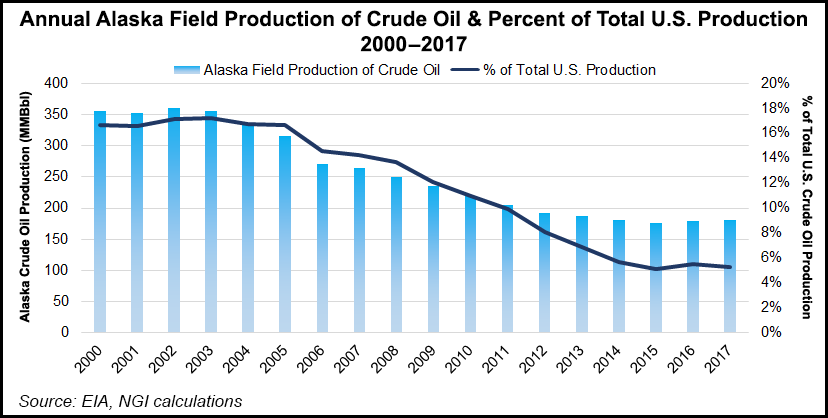Regulatory | NGI All News Access
Interior Said Moving Forward With ANWR Lease Sale in 2019
A Department of Interior official said the agency is moving forward to open a portion of the Alaska National Wildlife Refuge (ANWR) to oil and natural gas leasing in 2019, and predicted that a lease sale scheduled for the region will attract significant interest from producers.

Interior’s Joe Balash, assistant secretary for land and minerals management, said federal lands within his home state of Alaska holds billions of bbl of oil and several Tcf of natural gas.
“We are looking at ways to expand the inventory of onshore federal lands available for lease, as well as continuing to lease available lands,” Balash told attendees of the America First Energy Conference, an event in New Orleans last week sponsored by the Heartland Institute, a conservative think tank. “One way we’re doing this is by further opening up frontier areas.”
Balash pointed to an updated assessment completed last year by Interior agencies that found Alaska’s onshore and offshore collectively hold about 17.6 billion bbl and more than 50 Tcf of natural gas. As part of that assessment, Interior’s U.S. Geological Survey (USGS) estimated that the National Petroleum Reserve in Alaska (NPR-A), as well as adjacent state and native lands, hold an estimated mean of 8.7 billion bbl and 25 Tcf, resources that were classified as undiscovered, technically recoverable.
The latest survey marked a near six-fold increase in oil from a previous assessment conducted in 2010, which found a mean of 1.5 billion bbl.
“It was a little embarrassing that it took that long to catch up because ConocoPhillips has been exploring in the NPR-A” for many years, Balash said. “They’re now in the final stages of developing their second production facility in the region, and with the confirmation of some exploration wells earlier in the year,” and in a filing with the Securities and Exchange Commission, “it looks like they have more than 1 billion bbl already identified, and they haven’t even scratched the surface.” He claimed that “more than 78% of their lands under lease have not yet been explored.”
Balash also touched on plans to open 2,000 acres of the 1.5-million acre coastal plain portion of ANWR, a region also known as the 1002 Area, to energy development.* Development was included in a controversial policy rider attached to the $1.5 trillion comprehensive tax reform bill enacted last year.
“As private industry has made clear, there’s a definite demand from the market for this additional acreage,” Balash said. “We’re working now with the State of Alaska and the local government, the North Slope Borough, to redevelop an integrated activity plan in the region that will make millions more acres available for leasing and opening up some of the most prospective areas closest to the Barrow Arch…
“My expectation is that if we do our work right at the department…if we get our environmental impact statement done and hold a lease sale sometime next year, I think there are going to be some eye-popping numbers that show up at that lease sale.”
Meanwhile, a magnitude-6.4 earthquake, the most powerful temblor to hit Alaska’s North Slope, struck just south of ANWR territory on Sunday morning but reportedly caused no damage to oil and gas infrastructure in the region.
A magnitude-6.4 earthquake struck at 6:58 a.m. local time on Sunday, according to USGS. The epicenter of the quake was 84 kilometers (52.2 miles) southwest of Kaktovik, AK, in the Sadlerochit Mountains and outside the boundaries of ANWR. A series of 12 aftershocks measuring 4.5-6.0 in magnitude hit the region throughout the day on Sunday and into Monday, with epicenters 63-85 kilometers (39.1-52.8 miles) to the southwest of Kaktovik, according to USGS.
The Fairbanks, AK-based Alaska Earthquake Center (AEC) reported Sunday that it had received no reports of damage or injuries. “At present there is no evidence to suggest subsequent earthquakes larger than the 6.4 main shock. Scientifically, however, this region is poorly understood, and the behavior of the fault or faults responsible for today’s earthquake are not known.
“This earthquake will be extremely important for understanding North Slope seismicity and, more generally, how seismic waves travel throughout Alaska.”
Alyeska Pipeline Service Co., the consortium that owns and operates the Trans-Alaska Pipeline System (TAPS), tweeted Sunday that “there was no impact to TAPS operations and there are no operational concerns” from the quake. “Per Alyeska protocol, there will be inspections of the pipeline and facilities along the northern segment of TAPS.”
ExxonMobil Alaska, a subsidiary of ExxonMobil Corp., also tweeted “that all staff are safe, and an initial site assessment at Point Thomson found no damage or impact.” Point Thomson is 60 miles west of Kaktovik.
*Clarification: The comprehensive tax reform bill repealed a portion of Section 1003 of the Alaska National Interest Lands Conservation Act that barred energy development in the 1002 Area, and directed Interior’s secretary to manage an oil and gas leasing program according to the Naval Petroleum Reserves Production Act of 1976. The bill also stipulated that Interior conduct a lease sale within four years, followed by a second lease sale within seven years of enactment. Each lease sale must contain at least 400,000 acres with a high potential for oil and gas assets. Within the 1002 Area, 2,000 surface acres would be used for production and support facilities during the terms of the leases under the new oil and gas leasing program.
© 2024 Natural Gas Intelligence. All rights reserved.
ISSN © 1532-1231 | ISSN © 2577-9877 |
